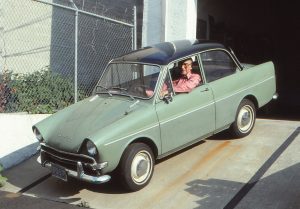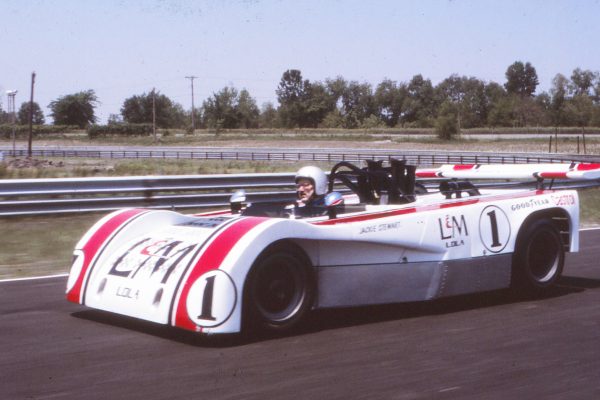History/driving impression originally published in Sport Compact Car March 2000; republished by the author

The Amsterdam Automobile Show in early 1958 was an unlikely venue for a new car introduction, but then the car being introduced was rather unlikely. Powered by a horizontally-opposed twin-cylinder air-cooled engine and sporting peculiar shovel-nosed front end styling that could come only from a country so close to France, the new car’s continuously variable transmission was its primary claim to fame. How right for the bicycle-writing Dutch! But since it was the first car actually to be made in The Netherlands since the luxurious Spijker was last produced in 1920, it was appropriate for its revealing to be in his homeland. A year later, the first DAF went on sale.
DAF automobiles were the product of two brothers, Hubert and Wim van Doorne. Hubert had operated an engineering firm since the late ‘20s and Wim handled the business side of things. By the ‘50s the Van Doornes were heavily into commercial vehicles, but the foray into passenger cars came from Hubert’s invention of what would become known as the Variomatic transmission.
Mounted under the rear seat, the transmission was comprised of rubber V-belts and pulleys, one set per rear wheel. The power came back from the front-mounted engine via a conventional driveshaft, but it T’d forward of the rear wheels. The effective diameter of the pulleys could be changed by altering the spacing between the sides. The closer together, the higher the belt would ride in the pulley.
The Van Doore system accomplished this by a combination of centrifugal weights and engine vacuum. The pulley at the wheel and of the belt was held together by springs and as the front pulley got larger, the belt was pulled deeper into the rear pulley, thus changing the ratio. But DAF, instead of making the familiar noises of a car going through the gears, maintained a more or less constant engine sound as it accelerated. The sole transmission control was a lever on the floor for “Drive” and “Reverse.”
Though some predicted a short life for the V-belts, most worked well for the predicted 30,000-mile life which, in a small country like Holland, could be a long time. The DAF caught on across Europe, however, and an ambitious importer even begin bringing the 22 hp, 590 cc DAF 600s to the United States. A larger engine prompted a redesignation as the 750, and a fancier version was given the two-cute name DAFfodil, complete with a flower emblem on the steering wheel. An idiosyncrasy of the Variomatic transmission was centrifugal clutch that was part of the system. Foreign tourists renting DAFs in Holland would leave the cars parked in Drive, not realizing that it wouldn’t hold the car. The rental DAFfodil floating in a Dutch canal was not an uncommon sight.
By 1966, DAF had become such a cosmopolitan automobile that its next new model was introduced at that year’s Paris Auto Show. The 44 continued with the air-cooled boxer twin, though bigger for more power, an even 40 bhp at 4500 rpm, and a complete restyling. Cynics complained it had none of the earlier DAF’s charms, though the Michelotti-designed body was almost handsome if more like other European subcompacts. Which, of course, is exactly what DAF wanted.
The DAF 55 followed a year later and it introduced another change, a water-cooled in line 4-cylinder engine made by Renault. The 55 was smoother and quieter and, with 50 hp at 5000 rpm and 62 lb-ft of torque at 3000 rpm, faster to boot. The 55 could run up to 85 mph (compared to the original 750’s 62 mph flat out top-end) and sprinted to 50 mph in town 12 seconds. All, of course, still with the DAF transmission. It was small, with an 88.6 inch wheelbase and an overall length of 151.6 inches.
DAF also made a Jeep -like military vehicle and the DAF transmission and the two-cylinder DAF engine even made it into a formula-type racecar. The DAF 55 eventually was replaced by the model 66, still with Variomatic and powered by an 1108 cc Renault engine. It was then that Volvo bought into DAF, securing one-third ownership in 1973. In January 1975, Volvo’s share increased to 75 percent, and in May, the Dutch car company’s name was changed to Volvo Car BV. A Volvo -like grill was slapped on the car itself, and its name was changed to the Volvo 66. A conventional manual transmission was offered in the Volvo 343 – originally to have been called the DAF 77 before the takeover – in 1979 but the DAF remained available until production ended in March, 1991.
Addendum: The DAF 55 that I drove was one of a collection of DAF’s owned by Casimir Wysocki, which I drove and wrote about for Automobile magazine (click here to read).








What Do You Think?
You must be logged in to post a comment.